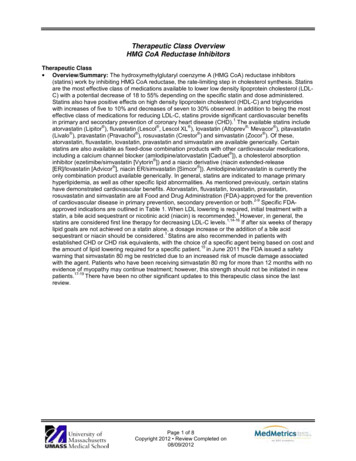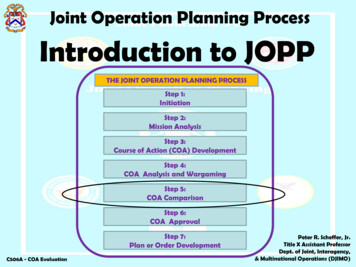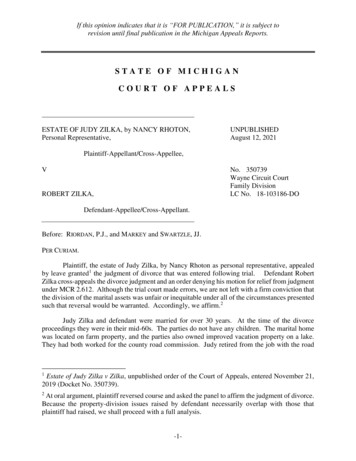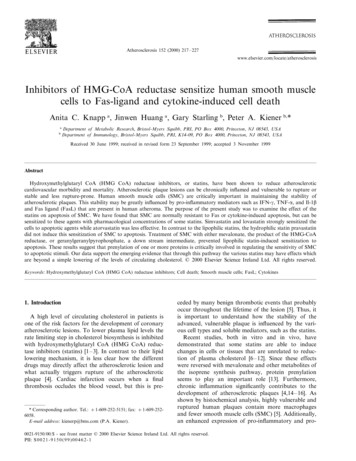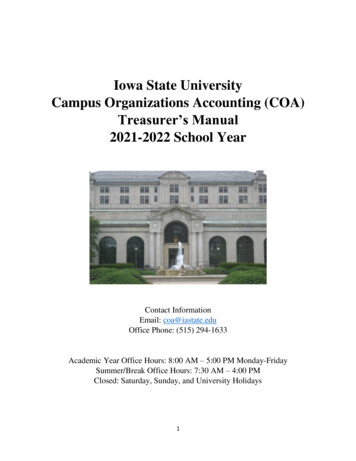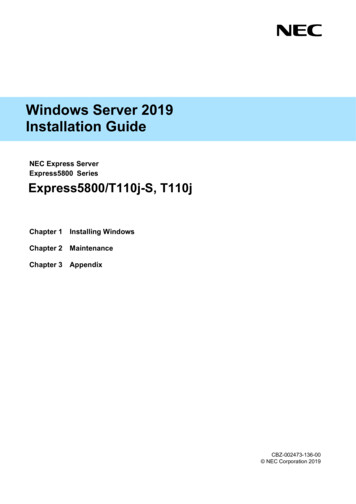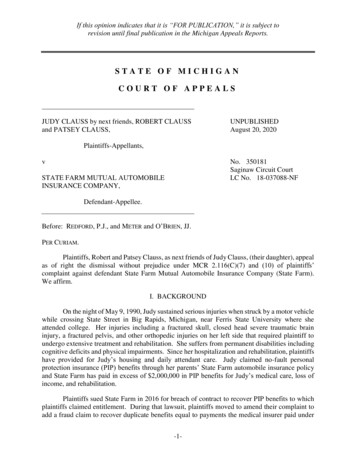
Transcription
If this opinion indicates that it is “FOR PUBLICATION,” it is subject torevision until final publication in the Michigan Appeals Reports.STATE OF MICHIGANCOURT OF APPEALSJUDY CLAUSS by next friends, ROBERT CLAUSSand PATSEY CLAUSS,UNPUBLISHEDAugust 20, 2020Plaintiffs-Appellants,vNo. 350181Saginaw Circuit CourtLC No. 18-037088-NFSTATE FARM MUTUAL AUTOMOBILEINSURANCE COMPANY,Defendant-Appellee.Before: REDFORD, P.J., and METER and O’BRIEN, JJ.PER CURIAM.Plaintiffs, Robert and Patsey Clauss, as next friends of Judy Clauss, (their daughter), appealas of right the dismissal without prejudice under MCR 2.116(C)(7) and (10) of plaintiffs’complaint against defendant State Farm Mutual Automobile Insurance Company (State Farm).We affirm.I. BACKGROUNDOn the night of May 9, 1990, Judy sustained serious injuries when struck by a motor vehiclewhile crossing State Street in Big Rapids, Michigan, near Ferris State University where sheattended college. Her injuries including a fractured skull, closed head severe traumatic braininjury, a fractured pelvis, and other orthopedic injuries on her left side that required plaintiff toundergo extensive treatment and rehabilitation. She suffers from permanent disabilities includingcognitive deficits and physical impairments. Since her hospitalization and rehabilitation, plaintiffshave provided for Judy’s housing and daily attendant care. Judy claimed no-fault personalprotection insurance (PIP) benefits through her parents’ State Farm automobile insurance policyand State Farm has paid in excess of 2,000,000 in PIP benefits for Judy’s medical care, loss ofincome, and rehabilitation.Plaintiffs sued State Farm in 2016 for breach of contract to recover PIP benefits to whichplaintiffs claimed entitlement. During that lawsuit, plaintiffs moved to amend their complaint toadd a fraud claim to recover duplicate benefits equal to payments the medical insurer paid under-1-
plaintiffs’ medical insurance policy because plaintiffs’ policies were not coordinated. Plaintiffsbased their fraud claim on a statement allegedly made in the Fall of 1990 by a State Farmrepresentative that State Farm would no longer make such duplicate payments. The trial courtdenied the motion because plaintiffs failed to allege in their proposed fraud claim’s allegations thebreach of a duty distinct from contract obligations. The trial court also concluded that the damagesthey sought for their fraud claims were the same as the PIP benefits that they sought for theirbreach of contract claim. While their 2016 case remained pending, plaintiffs filed another lawsuitagainst State Farm in 2017 that asserted the same breach of contract claim and added the fraudclaim. The parties negotiated a settlement and submitted stipulated orders for dismissal of the2016 and 2017 cases without prejudice. The trial court entered the stipulated orders and closedthose cases on November 28, 2017.Shortly after the dismissal of the two lawsuits, on January 9, 2018, plaintiffs executed a“RELEASE OF PIP CLAIMS” (the Release) which provided that plaintiffs released anddischarged State Farm from any and all actions, causes of action, claims, demands, and damagesthat arose from the 1990 accident except that State Farm would continue paying plaintiffs forJudy’s attendant care. Nevertheless, a few months later, on July 31, 2018, plaintiffs filed theircomplaint in this case. Plaintiffs alleged a breach of contract claim similar to the ones alleged inthe 2016 and 2017 cases and they alleged the same fraud claim. State Farm answered and latermoved for summary disposition under MCR 2.116(C)(7) and (10) on the grounds that no genuineissue of material fact existed that it had failed to pay any outstanding PIP benefits, that plaintiffswere barred by res judicata from stating a fraud claim, and that plaintiffs’ claims were barred bythe Release. Plaintiffs opposed State Farm’s motion by arguing that the res judicata doctrine didnot apply because they voluntarily dismissed their previous lawsuits, and they contended that theywere not precluded by the terms of the Release from filing their lawsuit. The trial court grantedState Farm summary disposition and dismissed plaintiffs’ lawsuit because the Release precludedthem from asserting claims against State Farm. Plaintiffs moved for reconsideration, State Farmresponded to the motion as directed by the trial court, and the trial court determined that nopalpable error existed that warranted a different disposition. Plaintiffs now appeal.II. STANDARDS OF REVIEWWe review de novo a trial court’s ruling on a motion for summary disposition under MCR2.116(C)(7). Shay v Aldrich, 487 Mich 648, 656; 790 NW2d 629 (2010).When determining whether a motion for summary disposition brought pursuant toMCR 2.116(C)(7) was properly decided, this Court considers all documentaryevidence and accepts the complaint as factually accurate unless affidavits or otherdocuments presented specifically contradict it. This issue also involves questionsof law regarding the construction of a contract, which we review de novo as well.[Id. (citations omitted).]We also review de novo decisions on motions for summary disposition under MCR2.116(C)(10). Mendelson Orthopedics, PC v Everest National Ins Co, 328 Mich App 450, 456;938 NW2d 739 (2019).-2-
A motion brought pursuant to MCR 2.116(C)(10) tests the factual support of aplaintiff’s claim and is reviewed by considering the pleadings, admissions, andother evidence submitted by the parties in the light most favorable to the nonmovingparty. Summary disposition is appropriate if there is no genuine issue regardingany material fact and the moving party is entitled to judgment as a matter of law.A genuine issue of material fact exists when reasonable minds could differ on anissue after viewing the record in the light most favorable to the nonmoving party.[Id. at 456-457 (quotation marks and citations omitted.)]To avoid summary disposition after the movant has satisfied its burden:Where the burden of proof at trial on a dispositive issue rests on a nonmoving party,the nonmoving party may not rely on mere allegations or denials in pleadings, butmust go beyond the pleadings to set forth specific facts showing that a genuine issueof material fact exists. If the opposing party fails to present documentary evidenceestablishing the existence of a material factual dispute, the motion is properlygranted. [Lowrey v LMPS & LMPJ, Inc, 500 Mich 1, 7; 890 NW2d 344 (2016)(citations omitted).]In Maiden v Rozwood, 461 Mich 109, 121; 597 NW2d 817 (1999), our Supreme Courtexplained that “[a] litigant’s mere pledge to establish an issue of fact at trial cannot survivesummary disposition under MCR 2.116(C)(10). The court rule plainly requires the adverse partyto set forth specific facts at the time of the motion showing a genuine issue for trial.”III. ANALYSISPlaintiffs argue that the trial court erred by dismissing their fraud claim because the Releasedid not bar the claim and they contend that Cooper v Auto Club Ins Ass’n, 481 Mich 399; 751NW2d 443 (2008), which held that fraud claims against insurers are not subject to the no-faultone-year-back rule, permitted their fraud claim. We find no merit to plaintiffs’ arguments.In Genesee Foods Servs, Inc v Meadowbrook, Inc, 279 Mich App 649, 655-656; 760 NW2d259 (2008) (quotation marks, alteration, ellipsis, and citations omitted), this Court explained:A release of liability is valid if it is fairly and knowingly made. This Court set forththe following rules regarding the scope and interpretation of a release:The scope of a release is controlled by the intent of the parties as itis expressed in the release. If the text in the release is unambiguous,we must ascertain the parties’ intentions from the plain, ordinarymeaning of the language of the release. The fact that the partiesdispute the meaning of a release does not, in itself, establish anambiguity. A contract is ambiguous only if its language isreasonably susceptible to more than one interpretation. If the termsof the release are unambiguous, contradictory inferences become“subjective, and irrelevant,” and the legal effect of the language is aquestion of law to be resolved summarily.-3-
We read contracts as a whole and accord their terms their plain and ordinarymeaning. Unambiguous contracts are to be enforced as written unless a contractualprovision violates law or public policy.In Reicher v SET Enterprises, Inc, 283 Mich App 657, 663-664; 770 NW2d 902 (2009)(citations omitted), this Court stated that an “agreement to settle a pending lawsuit is a contract,governed by the legal rules applicable to the construction and interpretation of other contracts.Moreover, by definition, a settlement agreement is a compromise of a disputed claim.” This Courtexplained:Michigan courts enforce contracts. We enforce contracts according to theirterms, as a corollary to the parties’ liberty to enter into a contract. We examinecontractual language and give the words their plain and ordinary meanings. Anunambiguous contractual provision reflects the parties’ intent as a matter of law,and if the language of the contract is unambiguous, we construe and enforce thecontract as written. Courts may not create ambiguity when contract language isclear. Rather, this Court must honor the parties’ contract, and not rewrite it. [Id. at664-665 (quotation marks, alteration, and citations omitted).]In this case, the Release provided in relevant part:IN CONSIDERATION of the payment to the undersigned, ROBERTCLAUSS AND PATSEY CLAUSS, AS NEXT FRIEND OF JUDY CLAUSS, inthe amount of THIRTY-ONE THOUSAND, FIFTY ( 31,050.00) Dollars, thereceipt of which is hereby acknowledged, the undersigned . . . does hereby releaseand forever discharge [State Farm] of and from any and all actions, causes of action,claims, demands, damages, costs, loss of services, expenses and/or compensationon account of, or in any way growing out of, any and all known or unknownpersonal injuries and property damage resulting or to result from an accident thatoccurred on or about May 9, 1990.IT IS expressly agreed that this Release refers to any and all benefits,including attendant care up to date, household chores, any and all outstanding bills,mileage and payment of a premium for health insurance or that may arise from theMay 9, 1990 accident.IT IS expressly understood and agreed that the above-named sum paid isthe sole consideration of this release, and in making this release and agreement it isunderstood and agreed that the undersigned rely upon the undersigned’s ownjudgment, belief, and knowledge of the nature, extent and duration of said injuries,and that the undersigned has not been influenced to any extent whatever in makingthis release by any representations or statements regarding said injuries, orregarding any other matters made by persons, firms or corporations who are herebyreleased, or by any person or persons representing them or by any physician orsurgeon employed by them.-4-
It is further understood and agreed between the above parties to thisagreement that [State Farm] will continue payments for attendant care at the rate offourteen dollars ( 14.00) per hour, twenty-four hours per day for two years fromthe date of this release, at which time this agreement may be re-evaluated regardingany continued attendant care claim. Said re-evaluation may consist of, but notlimited to, gathering updated medical records and conducting independent medicalexaminations, if warranted.IT IS further understood and agreed that the above payment is made in thecompromise of a disputed claim, and that the payment is not to be construed as anadmission of any liability therefor, such liability having been expressly denied.* * *THIS release contains the ENTIRE AGREEMENT between the partieshereto, and the terms of this release are contractual and not a mere recital. Theundersigned has CAREFULLY READ this release, fully understands it, and signsthis as the free and voluntary act of the undersigned.The record reflects that plaintiffs and State Farm settled the 2016 and 2017 cases, and aspart of the parties’ settlement, plaintiffs executed the Release in return for the payment of 31,050.The language of the Release is not reasonably susceptible to more than one meaning. Therefore,the Release lacks ambiguity which required the trial court to enforce it as written according to itsplain and ordinary terms.The Release plainly required plaintiffs to release and forever discharge State Farm fromany and all actions, causes of action, claims, demands, damages, costs, loss of services, expensesand/or compensation in any way related to the May 9, 1990 accident. The Release in no wayexcluded any claims from release or preserved any claims that preexisted the date on whichplaintiffs executed the Release.The Release language necessarily included the claims asserted in plaintiffs’ 2018 complaintrelated to State Farm’s alleged breach of contract and claims stemming from the alleged Fall of1990 misrepresentation regarding payment of PIP benefits to plaintiffs that duplicated paymentsmade by their medical insurer. The Release’s use of the terms “any and all actions, causes ofaction” unquestionably encompassed the claims plaintiffs sought to assert in their 2018 complaintwhich they released by executing the Release. See Dresden v Detroit Macomb Hosp Corp, 218Mich App 292, 297-298; 553 NW2d 387 (1996) (explaining that a release that stated “ ‘any andall’ causes of action” sufficed to bar the plaintiff’s fraud claim); see also Heritage Resources, Incv Caterpillar Fin Serv Corp, 284 Mich App 617, 642; 774 NW2d 332 (2009) (holding that thebroad language used in a settlement sufficed to release all claims, because, “[T]here cannot be anybroader classification than the word ‘all.’ In its ordinary and natural meaning, the word ‘all’ leavesno room for exceptions.”) (quotation marks and citation omitted). Accordingly, the Release in thiscase foreclosed plaintiffs from raising claims against State Farm regardless of the legal theoriesthey invoked or the allegations they made.-5-
Plaintiffs argue that, despite the Release, because Cooper held that the no-fault one-yearback rule did not bar a fraud claim against an insurer, their fraud claim remained viable and couldbe asserted in their 2018 case. We disagree.In Cooper, 481 Mich at 401, our Supreme Court addressed the issue whether the no-faultone-year-back rule of MCL 500.3145(1) barred the plaintiff’s common law fraud claim. It heldthat a fraud claim is not a no-fault action for the recovery of PIP benefits but an “independent anddistinct action for recovery of damages payable under the common law for losses incurred as aresult of the insurer’s fraudulent conduct” and, therefore, a fraud claim is not subject to the oneyear-back rule. Id. Our Supreme Court, however, did not address the issue presented in this casewhich is whether a release of all claims barred the plaintiffs’ fraud claim. Because this casepresents a distinctly different issue, Cooper is inapposite. Cooper never discussed or decided theissue presented in this case and plainly does not stand for the proposition that a claim releasedunder the broad terms of a release may be raised despite having been waived and released bycontract.1The record reflects that the trial court in this case closely examined the Release andcorrectly determined that it plainly and unambiguously provided that plaintiffs relinquished “anyand all” claims against State Farm regardless of the legal theories on which they based their claims.The trial court properly ruled that the Release provided that plaintiffs “gave up every possiblecause of action against State Farm up to the date of the release.” The trial court properly concludedthat the terms of the Release barred plaintiffs’ claims made in their 2018 case.Plaintiffs also suggest without citation to any authority that e-mail correspondence betweentheir counsel and defense counsel before their execution of the Release somehow preserved theviability of their fraud claim. The trial court properly recognized that plaintiffs improperly soughtto introduce parol evidence to vary the unambiguous terms of the Release and it correctly declinedto do so because plaintiffs failed to establish any legal basis to depart from the four corners of theRelease. The trial court discerned that the Release contained a merger clause that indicated that itcontained the entire agreement between the parties and by its terms plaintiffs released State Farm1Cooper also does not modify the accrual of a fraud claim or the running of the statute oflimitations period. Under MCL 600.5813, a fraud claim must be brought within six years fromthe time the claim accrues. Under MCL 600.5827 a claim accrues when the wrong is done, unlessMCL 600.5829 to MCL 600.5838 apply. None of those statutes apply in this case. The wrong isdone when the plaintiff is harmed rather than when the defendant acted. Stephens v Dixon, 449Mich 531, 534-535; 536 NW2d 755 (1995). The accrual of a fraud claim is not extended until theplaintiff discovers or should have discovered the claim. Boyle v General Motors Corp, 468 Mich226, 231; 661 NW2d 557 (2003). In this case, for their fraud claim plaintiffs alleged that StateFarm made a misrepresentation regarding its PIP benefits payment obligation in the Fall of 1990,more than 26 years before plaintiff filed suit, and after that misrepresentation failed to pay the“double dip” PIP benefits. The harm, therefore, occurred in 1990 and the six-year statute oflimitations period began running and elapsed during the Fall of 1996. Plaintiffs’ fraud claim,therefore, was barred by the statute of limitations because they waited over 26 years to bring suit.The trial court could have dismissed the claim on this basis.-6-
from all claims of whatever kind up to the date of the Release. The trial court, therefore, did noterr in this regard.Moreover, the e-mail correspondence from defense counsel on which plaintiffs rely plainlystated that, should plaintiffs refile their fraud claim, State Farm retained all of its defenses. Afterthe parties corresponded through counsel, plaintiffs voluntarily executed the Release. Plaintiffs’protestations regarding the scope of the Release appear to be an expression of buyer’s remorse. Achange of heart, however, has never been deemed sufficient to justify the setting aside of asettlement agreement or release or departing from enforcement of such agreements’ plainlanguage.Plaintiffs assert other claims of error on appeal but we decline to consider them becausethe trial court did not address or decide the issues but correctly focused its analysis and decisionon the Release alone which is dispositive in this case. The trial court did not err by ruling that theplain language of the Release barred plaintiffs from bringing claims against State Farm, includingtheir fraud claim, and it appropriately granted State Farm summary disposition.Affirmed./s/ James Robert Redford/s/ Patrick M. Meter/s/ Colleen A. O’Brien-7-
Judy claimed no-fault personal protection insurance (PIP) benefits through her parents' State Farm automobile insurance policy and State Farm has paid in excess of 2,000,000 in PIP benefits for Judy's medical care, loss of income, and rehabilitation. Plaintiffs sued State Farm in 2016 for breach of contract to recover PIP benefits to which

